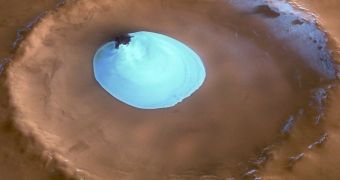Launched by the European Space Agency in 2003, the Mars Express was the first European spacecraft in the orbit of the Red Planet. After four years of continuous study of the planet's surface and sending countless images, this Friday the orbiter will complete its 5000th orbit around Earth's sister planet.
Equipped with state of the art probing tools, the Mars Express provided valuable data, which expanded the knowledge related to Mars. The spacecraft was originally formed of two component parts, the Mars Express Orbiter and the Beagle 2 lander, but due to the fact that Beagle 2 was unable to safely land on the Martian surface, only the Orbiter is currently operational. The High-Resolution Stereo Camera or HRSC was able to produce detailed color pictures of the Martian surface, surprising giant inactive volcanoes, valleys and craters filled with water, in the form of ice.
Instruments surveying the planet's surface, such as the Visible and Infrared Mineralogical Mapping Spectrometer, have been successful in finding soils similar to the clays and hydrated minerals present on Earth, which might have formed earlier, when liquid water could have been present in abundant amounts on its surface. Studying the composition of the surface at the poles, OMEGA was able to determine the chemical composition and also create maps of locations where water ice and dry ice is present.
The Mars Advanced Radar for Subsurface and Ionospheric Sounding, or MARSIS, whose primary mission was to study Mars' unique ionosphere, the most upper layer of the atmosphere, was able to penetrate the surface, only to reveal that there is enough ice in the subsurface to create an ocean that could cover the surface of the planet with a layer of water 11 meters deep.
While the Ultraviolet and Infrared Atmospheric Spectrometer created a complete vertical profile of Mars' atmosphere to determine the temperature and carbon dioxide density, the Planetary Fourier Spectrometer has made a complete map of the chemical composition of the atmosphere.
The tools aboard the Mars Express also confirmed the prediction that the solar wind will have an influence on the atmosphere at altitudes as low as 270 kilometers, by partially stripping atoms, but the measurement showed that the rate at which the atmosphere is decreasing is extremely low, compared to the levels calculated by astronomers.
ESA decided to extend the Mars Express mission at least until 2009 and is considering the possibility of further extending it in the next decade. However to continue the mission, the spacecraft's orbit must suffer minor adjustments, due to small gravitational anomalies which altered its trajectory. The MaRS radio experiment was able to detect these anomalies, while studying the surface roughness.

 14 DAY TRIAL //
14 DAY TRIAL //